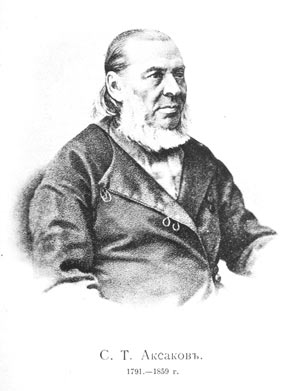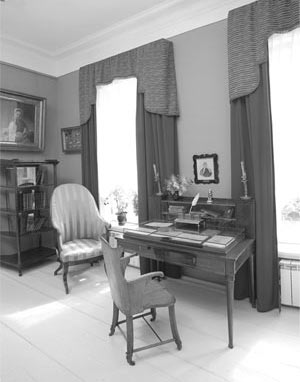THE AKSAKOVS' PERIODÂ
Sergey Aksakov (1791–1859), was born in Ufa (today the capital of the Bashkortostan Republic) in an old noble but not rich family. As a child he spent much time in the country estate of his grandfather in the Orenburg province. Aksakov got education at the Kazan Gymnasium that was transformed into the University during his study (1801–1807). After graduation he lived and worked in St. Petersburg where he made friends with the future members of the literary society "Discussion of the Russian Language Lovers": the poet Gavril Derzhavin, the writer, admiral and statesman Alexander Shishkov and others. In 1812 Aksakov returned to his native country estate near Orenburg and spent there one and a half decade, occasionally visiting St. Petersburg and Moscow. In 1816 Sergey Aksakov got married to Olga Zaplatina (1793–1860) with whom he lived all his life and had 14 children. His two sons, Konstantin (1817–1860) and Ivan (1823–1886), became eminent members of the Slavophil movement, upholding the original way of the historical development of Russia. Their brother Grigory (1820–1891) was the governor in Samara and in the Orenburg province, and he was also a member of Zemstvo (local legislature). In 1826 the Aksakovs moved to Moscow. Sergey Aksakov took into public service again: firstly as a censor (1827–1832), then as an inspector of the Konstantinovskoe Geodetic College. When this college was transformed into the Institute of Land Surveying, he became its director and occupied this post from 1833 till 1838. But after his father's death he came into fortune and soon retired. During these years of public service in Moscow and St. Petersburg Sergey Aksakov met literary and theatrical figures and became well-known as a theatrical critic. Among his friends were the writers Nikolay Gogol and Ivan Turgenev, the historian Mikhail Pogodin, the actor Mikhail Schepkin, the Slavophiles Ivan and Pyotr Kireevsky, Yury Samarin, Aleksey Khomyakov and other celebrated contemporaries. In 1843 after long searches of a suitable country estate Sergey Aksakov bought Abramtsevo. The Aksakovs brought little changes to the estate: the western façade of the manor house faced the rectangular courtyard surrounded by utility buildings – a servants` house, a kitchen, a shed with a barn, and a bathhouse. The only building, erected by the new owners to the south-east of the house was a living cottage. The estate and the park were not fenced and merged with nearby fields and forests. For Sergey Aksakov, a passionate fisherman and hunter, Abramtsevo was a place where he could relax after the vanity of Moscow. "It is a peaceful, solitary place that has everything we need", – he wrote to his son Ivan at the beginning of 1844. In Abramtsevo Sergey Aksakov matured as a writer and created his best literary works: "Notes on Angling" (1847) and "Notes of a Hunter from The Orenburg Province" (1852), autobiographical stories "Family Chronicle" (1856) and "Childhood Years of Bagrov the Grandson", the fairytale "The Scarlet Flower" (both in 1858). An outstanding gift of narration, keenness of observation and fidelity to life, accuracy and simplicity of language brought him fame. "If a black grouse could tell us about itself, I am sure, it would not add a single word to that already told about it by Mr. Aksakov", – Ivan Turgenev wrote about the book "Notes of a Hunter:" The Abramtsevo house opened its doors for Nikolay Gogol, Ivan Turgenev, Mikhail Pogodin, Mikhail Schepkin and other friends of the family. However, the death of Sergey Aksakov followed by the death of his eldest son Konstantin deserted Abramtsevo. In 1870 the estate was finally sold to Savva Mamontov. Â
|



